Abstract
The susceptibilities of a range of gram-positive and gram-negative microbial pathogens to clofazimine and its analog B669 (0.1 to 32 micrograms/ml), as well as the effects of these agents on membrane phospholipid metabolism in Staphylococcus aureus and Escherichia coli, have been investigated in vitro. Gram-positive bacteria were found to be generally susceptible to these agents, whereas gram-negative organisms were uniformly resistant. Exposure of S. aureus to both agents (1 to 5 micrograms/ml), especially B669, caused dose-related enhancement of the activity of phospholipase A2, according to an increase in the release of 3H-radiolabeled arachidonate and lysophosphatidylethanolamine ([3H]LPE) from bacterial-membrane phospholipids. Treatment of E. coli with the riminophenazines also increased the release of [3H]arachidonate and [3H]LPE. Growth of gram-positive but not gram-negative bacteria was inhibited by LPE and lysophosphatidylcholine. Moreover, coincubation with alpha-tocopherol (vitamin E), a lysophospholipid complex-forming agent, or with lysophospholipase protected gram-positive bacteria against the riminophenazines as well as against lysophospholipids. The results from this study are consistent with a mechanism whereby lysophospholipids mediate the activities of the two drugs.
Full text
PDF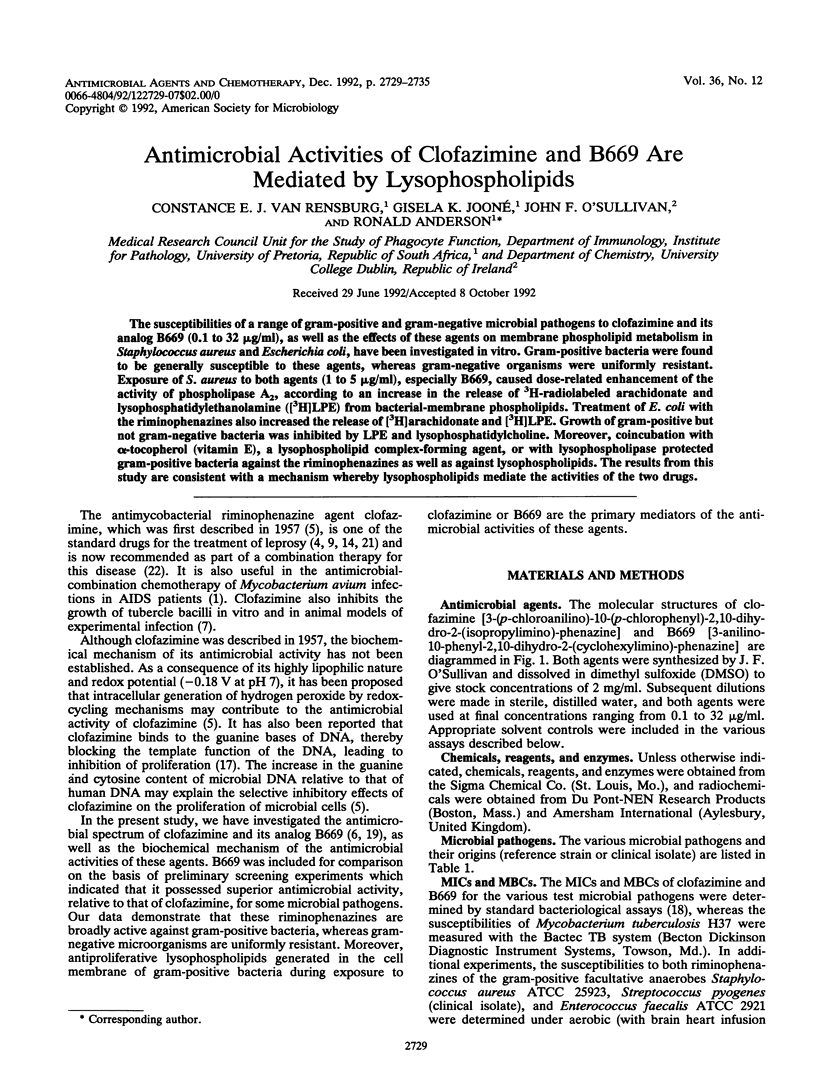
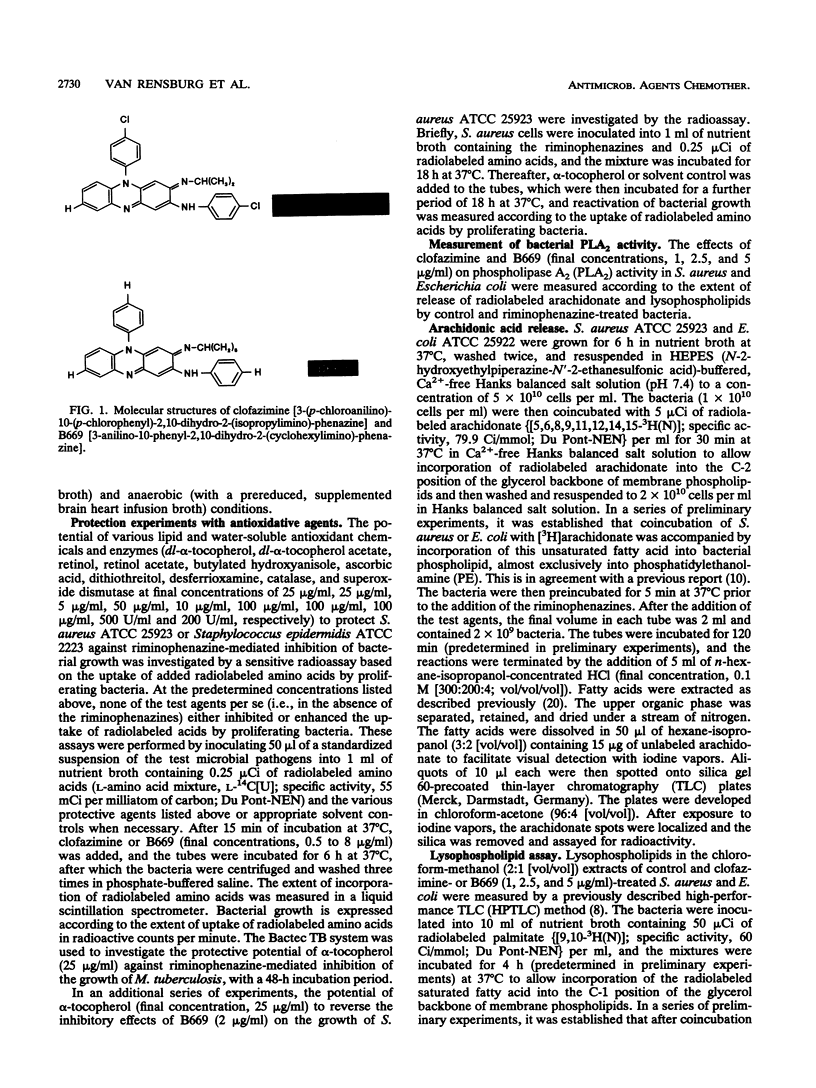
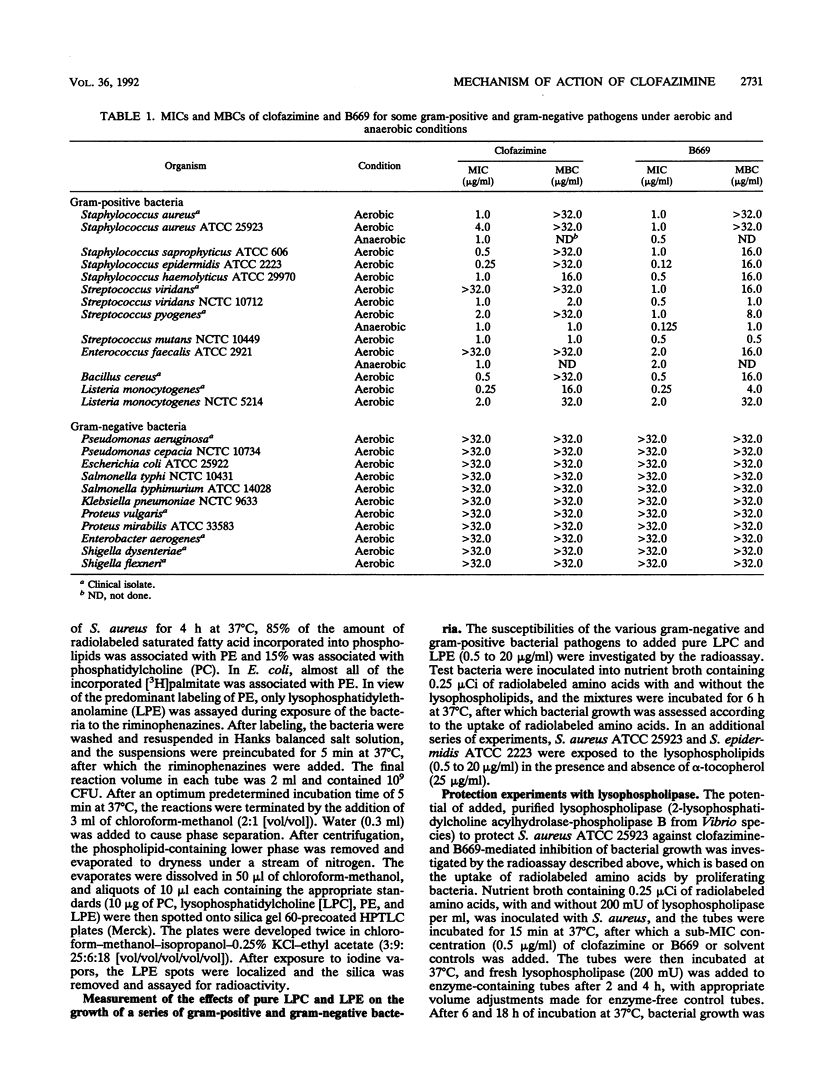

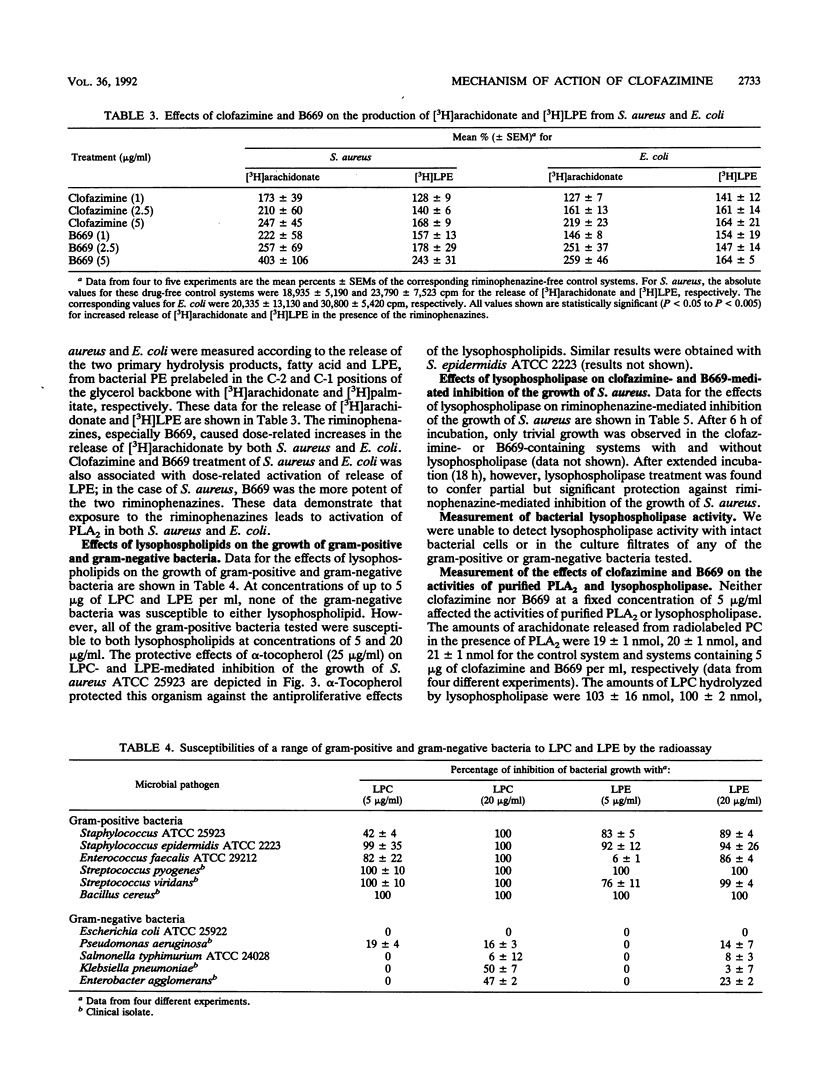
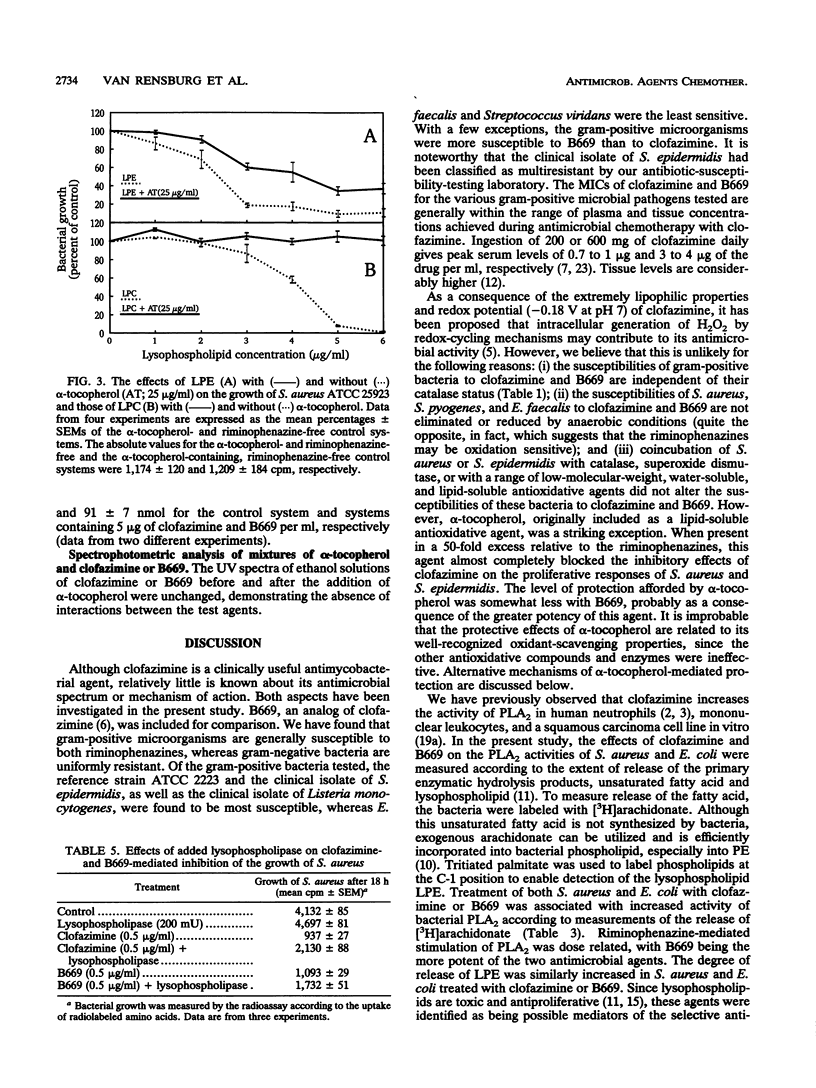
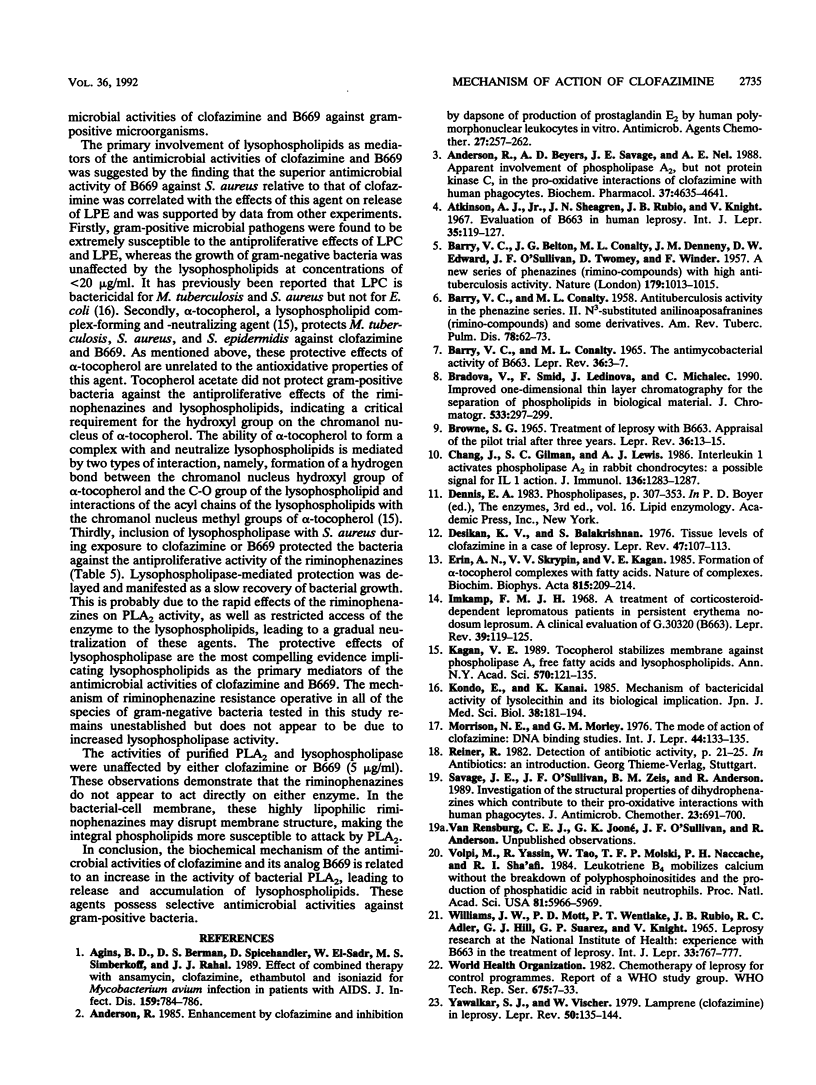
Selected References
These references are in PubMed. This may not be the complete list of references from this article.
- Agins B. D., Berman D. S., Spicehandler D., el-Sadr W., Simberkoff M. S., Rahal J. J. Effect of combined therapy with ansamycin, clofazimine, ethambutol, and isoniazid for Mycobacterium avium infection in patients with AIDS. J Infect Dis. 1989 Apr;159(4):784–787. doi: 10.1093/infdis/159.4.784. [DOI] [PubMed] [Google Scholar]
- Anderson R., Beyers A. D., Savage J. E., Nel A. E. Apparent involvement of phospholipase A2, but not protein kinase C, in the pro-oxidative interactions of clofazimine with human phagocytes. Biochem Pharmacol. 1988 Dec 15;37(24):4635–4641. doi: 10.1016/0006-2952(88)90332-2. [DOI] [PubMed] [Google Scholar]
- Anderson R. Enhancement by clofazimine and inhibition by dapsone of production of prostaglandin E2 by human polymorphonuclear leukocytes in vitro. Antimicrob Agents Chemother. 1985 Feb;27(2):257–262. doi: 10.1128/aac.27.2.257. [DOI] [PMC free article] [PubMed] [Google Scholar]
- Atkinson A. J., Jr, Sheagren J. N., Rubio J. B., Knight V. Evaluation of B.663 in human leprosy. Int J Lepr Other Mycobact Dis. 1967 Apr-Jun;35(2):119–127. [PubMed] [Google Scholar]
- BARRY V. C., BELTON J. G., CONALTY M. L., DENNENY J. M., EDWARD D. W., O'SULLIVAN J. F., TWOMEY D., WINDER F. A new series of phenazines (rimino-compounds) with high antituberculosis activity. Nature. 1957 May 18;179(4568):1013–1015. doi: 10.1038/1791013a0. [DOI] [PubMed] [Google Scholar]
- BARRY V. C., CONALTY M. L. Antituberculosis activity in the phenazine series. II. N3-substituted anilinoaposafranines (rimino-compounds) and some derivatives. Am Rev Tuberc. 1958 Jul;78(1):62–73. doi: 10.1164/artpd.1958.78.1.62. [DOI] [PubMed] [Google Scholar]
- BARRY V. C., CONALTY M. L. THE ANTIMYCOBACTERIAL ACTIVITY OF B 663. Lepr Rev. 1965 Jan;36:3–7. doi: 10.5935/0305-7518.19650002. [DOI] [PubMed] [Google Scholar]
- BROWNE S. G. TREATMENT OF LEPROSY WITH B 663 APPRAISAL OF THE PILOT TRIAL AFTER THREE YEARS. Lepr Rev. 1965 Jan;36:13–15. doi: 10.5935/0305-7518.19650004. [DOI] [PubMed] [Google Scholar]
- Bradová V., Smid F., Ledvinová J., Michalec C. Improved one-dimensional thin-layer chromatography for the separation of phospholipids in biological material. J Chromatogr. 1990 Nov 30;533:297–299. doi: 10.1016/s0378-4347(00)82217-3. [DOI] [PubMed] [Google Scholar]
- Chang J., Gilman S. C., Lewis A. J. Interleukin 1 activates phospholipase A2 in rabbit chondrocytes: a possible signal for IL 1 action. J Immunol. 1986 Feb 15;136(4):1283–1287. [PubMed] [Google Scholar]
- Desikan K. V., Balakrishnan S. Tissue levels of clofazimine in a case of leprosy. Lepr Rev. 1976 Jun;47(2):107–113. doi: 10.5935/0305-7518.19760020. [DOI] [PubMed] [Google Scholar]
- Erin A. N., Skrypin V. V., Kagan V. E. Formation of alpha-tocopherol complexes with fatty acids. Nature of complexes. Biochim Biophys Acta. 1985 May 14;815(2):209–214. doi: 10.1016/0005-2736(85)90291-3. [DOI] [PubMed] [Google Scholar]
- Imkamp F. M. A treatment of corticosteroid-dependent lepromatous patients in persistent erythema nodosum leprosum. A clinical evaluation of G.30320 (B663). Lepr Rev. 1968 Jul;39(3):119–125. doi: 10.5935/0305-7518.19680022. [DOI] [PubMed] [Google Scholar]
- Kagan V. E. Tocopherol stabilizes membrane against phospholipase A, free fatty acids, and lysophospholipids. Ann N Y Acad Sci. 1989;570:121–135. doi: 10.1111/j.1749-6632.1989.tb14913.x. [DOI] [PubMed] [Google Scholar]
- Kondo E., Kanai K. Mechanism of bactericidal activity of lysolecithin and its biological implication. Jpn J Med Sci Biol. 1985 Aug;38(4):181–194. doi: 10.7883/yoken1952.38.181. [DOI] [PubMed] [Google Scholar]
- Morrison N. E., Marley G. M. The mode of action of clofazimine DNA binding studies. Int J Lepr Other Mycobact Dis. 1976 Jan-Jun;44(1-2):133–134. [PubMed] [Google Scholar]
- Savage J. E., O'Sullivan J. F., Zeis B. M., Anderson R. Investigation of the structural properties of dihydrophenazines which contribute to their pro-oxidative interactions with human phagocytes. J Antimicrob Chemother. 1989 May;23(5):691–700. doi: 10.1093/jac/23.5.691. [DOI] [PubMed] [Google Scholar]
- Volpi M., Yassin R., Tao W., Molski T. F., Naccache P. H., Sha'afi R. I. Leukotriene B4 mobilizes calcium without the breakdown of polyphosphoinositides and the production of phosphatidic acid in rabbit neutrophils. Proc Natl Acad Sci U S A. 1984 Oct;81(19):5966–5969. doi: 10.1073/pnas.81.19.5966. [DOI] [PMC free article] [PubMed] [Google Scholar]
- Williams T. W., Jr, Mott P. D., Wertlake P. T., Rubio J. B., Adler R. C., Hill G. J., 2nd, Suarez G. P., Knight V. Leprosy research at the National Institutes of Health: experience with B.663 in the treatment of leprosy. Int J Lepr. 1965 Jul-Sep;33(3 Suppl):767–777. [PubMed] [Google Scholar]
- Yawalkar S. J., Vischer W. Lamprene (clofazimine) in leprosy. Basic information. Lepr Rev. 1979 Jun;50(2):135–144. doi: 10.5935/0305-7518.19790020. [DOI] [PubMed] [Google Scholar]


